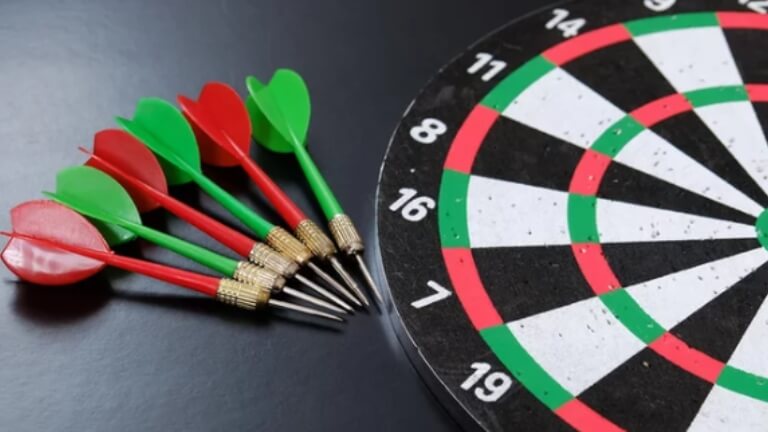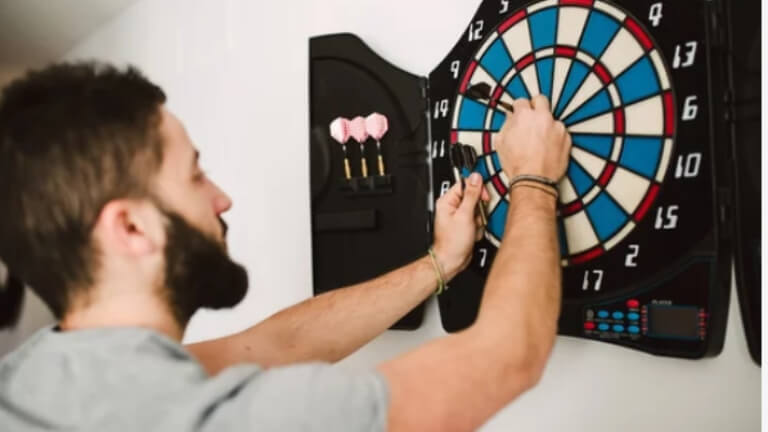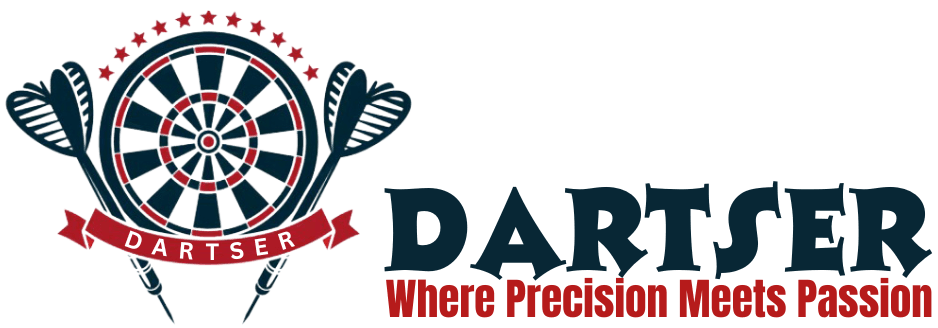If you think that darts is just a game, then you are wrong. Actually, the matter is not limited to this; here the game of darts takes the test of precision, mental toughness, focus, patience, and technique etc. Whether you play just for fun or try to compete at a high level, you need to have a lot of dedication to the game to achieve this goal.
The importance of playing regular darts on dartboard is something you will only understand by talking to the professionals. In this article, you will walk through 10 tips for better accuracy so that you can improve your dart-throwing mistakes.
1. Perfect Your Stance
To improve your dart-throwing stance, begin by finding a balanced and comfortable position. Stand with your body turned slightly to the side, facing the dartboard, and place your stronger foot forward, aiming it directly at your target.
Your other foot should help you stay steady, with most of your weight on the front foot. Make sure your throwing arm’s shoulder is pointing towards the dartboard, forming a straight line from your shoulder to the target. Don’t lean too far forward, as this can disrupt your balance.
Bend your knees a little and stay relaxed. Your other hand can either rest on your hip or hang freely. Consistency in your stance is important, as it sets the stage for a smooth and controlled throw.
Repeating this stance in practice will help your muscles remember it, letting you concentrate more on aiming and less on your position during games. You can make little changes over time to learn what works best and feel comfortable with yourself.
2. Grip the Dart Correctly
Your grip on the dart is the foundation and most important part of your accurate dart throw. Begin by gently holding the dart with your thumb and at least two fingers, usually your thumb, index, and middle fingers. You should hold the dart firmly enough to keep it steady, but not so tight that it limits its movement. A good grip helps the dart fly straight and correctly.
The usual way to hold a dart is with your thumb and two fingers (index and middle). Place your thumb under the dart to support it, and let your fingers lightly touch the sides. Some people like to use an extra finger (ring finger) for more control, especially when using heavier darts.
But this might make your throw slower, so it’s crucial to find a middle ground that suits you. Hold the dart inflexibly, but not too tightly. A loose grip makes for a smoother throw, keeping the dart on track. Keeping the same grip is important for improving your aim, so try to hold the dart the same way each time you play.
3. Focus on Your Target
Your eyes are very important when aiming. Look at the exact part of the dartboard you want to hit, not the whole board. Giving attention to your target is essential for accuracy in darts. Before you dart throw, look at the exact spot on the dartboard you want to hit, whether it’s the center or a specific area. This mental concentration assists the body and your mind towards getting an aim and thus, the chances of success in your throw are higher.

When you lift your arm to throw, keep your eyes on the target. Don’t let distractions or extra movements take away your focus. Imagine the dart’s path from your hand to the target, and let your throw follow that image. For example, if you find yourself in a stressful situation you can count to four and breathe in, then you count to four and breathe out.
Believe in your aim and complete the throw with a smooth, controlled motion. By focusing on your target frequently, it serves to build muscle memory as well as improve accuracy over time and is a significant aspect of mastering darts.
4. Maintain a Consistent Throwing Motion
Maintaining a consistent throwing motion is important for improving accuracy in darts. Begin by placing your arm at a right angle or 90-degree angle, making sure your elbow is pointing towards the target.
When you’re ready to throw, you should focus on a gentle and steady movement. Your lower arm should go straight ahead, while your elbow stays mostly in place. The goal is to make a smooth action that feels comfortable, avoiding sudden or rushed motions.
Let go of the dart at the highest point of your throw with a small flick of your wrist to help control and accuracy. After releasing the dart, keep your arm moving straight toward the target, with your hand pointing to where you want the dart to hit. Being consistent is key—doing the same action every time helps your muscles remember, which leads to more accurate throws.
5. Practice Your Release Timing
When you let go of the dart, improving your timing is important for making accurate and consistent throws in darts. The moment you release the dart is very important because it affects how the dart flies.
Start by finding a comfortable way to stand and hold the dart, then concentrate on a smooth and controlled throwing action. It’s best to release the dart just before your arm is fully stretched out when your hand is still a bit tilted upwards.

If you release the dart too soon or too late, it can cause the dart to miss its target. A good release should feel natural, with the dart gliding out of your hand rather than being forced. To get better at this, practice throwing at different speeds, always focusing on the moment the dart leaves your hand. Try making small changes in your timing until you find the perfect moment that makes your throws the most accurate.
6. Use the Correct Darts on the Dartboard
Selecting the correct darts is highly important for improving your skills in darts games. Picking the right ones can greatly affect your gameplay due to darts being of different sizes, forms, and materials. Begin by trying darts with different weights, usually from 18 to 26 grams. Heavier darts might give more steadiness, while lighter darts enable quicker throws.
Think about the shape of the barrel and the feel of the grip, as this influences how the dart feels in your hand. Some players like a smooth barrel, while others find a textured grip helps with control. The length and material of the shaft and wings also affect how the dart flies. Longer shafts can offer more steadiness, while shorter ones allow for quicker spins.
Ultimately, spend the time to find the set of darts that suits you best and that you feel comfortable with. Once you find your ideal set, keep using it for the best results.
7. Control Your Breathing
The way you breathe can greatly affect how well you throw. Quick or shallow breaths can make it hard to keep your hand steady, which can lead to poor throws. Learning to control your breathing can help you stay relaxed and concentrated, which can improve your throwing accuracy.
A good method is to take slow, deep breaths before each throw. Breathe in deeply through your nose, hold your breath for a second, and then breathe out slowly through your mouth. This can help steady your hand and improve your concentration, making it easier to throw accurately.
8. Mental Preparation
Having faith in yourself is very important for getting better at hitting your target. If you trust that you can hit the mark, then you will be more likely to succeed. Gaining confidence comes from practicing and saying positive things to yourself. Think about times you’ve done well before and concentrate on what you’re good at.
Visualizing means picturing your throw in your mind before you actually do it. See the dart leaving your hand and landing exactly where you want it to. This kind of mental practice can help you feel more confident and make you more accurate when you play for real.
9. Analyze and Learn from Your Mistakes
After every game or practice, spend some time looking at how you did. Remember the mistakes you often make and the patterns you see. Check where your darts usually land, and think about what you did right and what you could do better. If your darts often miss the target, try making small changes to how you hold the dart, how you stand, or how you throw it.
Don’t get upset about making mistakes; they help you learn. Think of them as part of getting better, and with each change you make, you’ll throw more accurately and feel more confident, slowly making your game better.
10. Practice Regularly
Regular practice is key to getting better at hitting your target. Set aside time every week to play darts. Consistent practice helps you build good habits and improves your muscle memory.
Change up your practice by aiming at different spots, practicing in various settings, and trying different games. This will prepare you for actual competitions, where stress and interruptions can happen. The more you train, the steadier and more precise your shots will get, which will result in improved performance in matches.

Frequently Asked Questions (FAQs)
How many darts for a dart board?
A standard game of darts is played with three darts per player. During their turn, they throw all three darts at the board, trying to get the most points they can. The darts can have either steel or soft tips, depending on the type of dartboard. For group games, it’s usual to have several sets of darts (three in each set), so everyone has their own darts to use.
When is the best time to play darts on dartboard?
The best time to play darts on dartboard is when you can concentrate well and feel awake. Early mornings or late evenings usually have less noise, which is good for practicing. It’s important to practice at the same time every day to get into a habit.
Also, think about how energetic you feel; pick a time when you’re most alert. If you’re preparing for a competition, practice at the same time the competition will happen to perform your best.
Can I use hard tip darts on a dartboard (Soft tip Dart Board)?
Hard tip darts or steel tip darts are basically used on bristle dartboards. Mainly, Soft tip darts are used on electronic dartboards. The point on a soft tip dart is made of a plastic material (plastic tip) and is best suited to a soft tip dartboard. It is always advised not to use steel tip darts on an electronic board. The sharp metal points on steel tip darts will damage your board and make it unusable.
How many numbers of games on darts connect online electronic dartboard?
The Darts Connect online electronic dartboard lets you play many different dart games, such as 501, Cricket, Shanghai, and others. The number of games you can play might be different based on the model and software version of the board. Usually, you’ll find a selection of games that fit different ways of playing and personal tastes.
Why 501 in darts?
Darts usually begin with a score of 501 because it offer a good balance between being challenging and doable in competitive games. Players have to bring their score down from 501 to exactly zero, with the last dart needing to hit a double.
This setup requires smart planning, as players need accurate scoring to end the game. The number 501 being odd means that at least one dart must be thrown before someone can win, which keeps the game fair and exciting.

